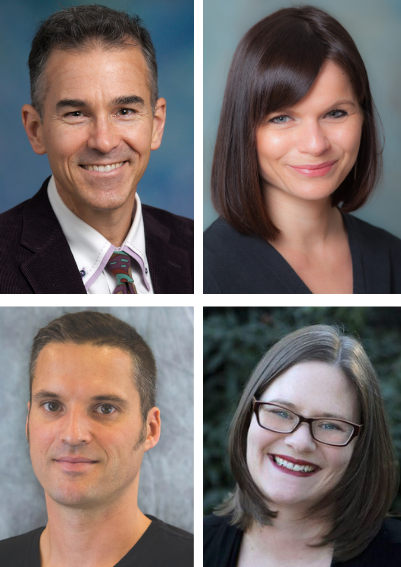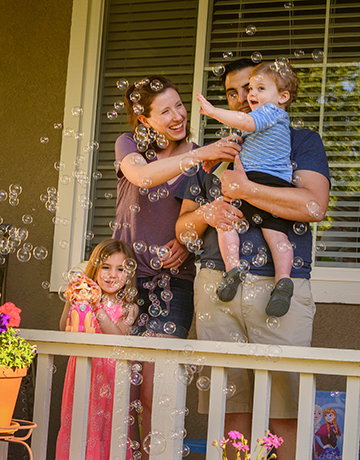Researchers study the social and emotional toll of sheltering in place, and ways people cope.
After COVID-19 precautions shut down the campus last spring — and with it most UC Davis laboratories — psychology professors turned their research upside down and shifted focus, fast.
Social scientists, in particular Professor of Psychology Paul Hastings, recognized the unprecedented human “experiment” presented by the pandemic and global efforts to “bend the curve.”
“In research methodology textbooks, this kind of situation is called a natural experiment,” Hastings said. “The world has done an experiment on the population. And these kinds of natural experiments open the possibility for gaining new knowledge.”
Humans, by nature, are social beings. How are they affected by long-term restrictions keeping them apart?
Hastings normally conducts physiological measurements to help understand the factors that shape social and emotional functioning from early childhood into adulthood.
He was engaged in multiple studies and about to launch more across the U.S. and in Ghana, Jordan, Bangladesh, and Chile. “All of those projects stopped,” he said. “For me, there was this period of, ‘What do I do with myself?’”
A new plan emerged quickly.
First, Hastings checked on the well-being of the 20 graduate and undergraduate students who work in his Healthy Emotions, Relationships and Development Laboratory at the Center for Mind and Brain.

After ensuring that everyone was OK, he organized a Zoom video meeting and presented the graduate students with a choice. “I said to them, ‘We can think of this as an opportunity to learn — and, by learning, to help. Do any of you feel like you have the bandwidth to start a new project now?”
With an enthusiastic “yes” from four graduate students, Hasting launched not just one but two new studies. The first looks at how people respond emotionally and socially to sheltering in place and physical distancing. The second examines the various ways that parents cope with having their children home full time, and how well those responses work for parents and children.
In addition to Hastings’ projects, two other studies in the Department of Psychology are exploring that question in the hopes of helping people best cope with this and future pandemics.
“We know from much briefer and more localized quarantines that there are adverse impacts on mental health,” Hastings said. “It’s one of the reasons why people in the mental health community very quickly mobilized to try to get messages out about being aware, doing things to protect yourself and your family.”
But until now, there has been little research on the human toll of extended, widespread quarantines. During the 1918–19 flu pandemic, psychology was a young science, focused more on perception and cognition. During the SARS outbreak in 2003, quarantines were limited to certain areas of East Asia and Canada.
A test of human nature
The personal impacts of social distancing took even psychology associate professor Eliza Bliss-Moreau by surprise, although she researches emotional and social experiences and their connections to healthy aging.
“I study this stuff — I think about this constantly. I had no idea how it would impact me,” said Bliss-Moreau, who is also a core scientist at the California National Primate Research Center at UC Davis.
“It doesn’t matter what culture, ethnic group, race, or age — healthy humans are social beings. And that is being put to the test in an interesting way.”
Like Hastings and other colleagues, Bliss-Moreau had to put experiments on hold. With her research team scattered, she said, “There was a lot of checking in. And then pretty quickly, by the second week of March, ‘Wow, life got really different, really fast. We should be studying this.’”
With doctoral candidate Anthony Santistevan, Bliss-Moreau created a survey asking people about their emotional and social experiences before and during the pandemic.
Top 10 Emotional Responses to the Pandemic
- Compassion
- Love
- Nervousness
- Gratitude
- Sadness
- Disappointment
- Sluggishness
- Sleepiness
- Moral disgust
- Anger
From preliminary findings of a survey by psychology researchers Eliza Bliss-Moreau and Anthony Santistevan.
Love, compassion, and reasons for hope
Preliminary results from data collected March 30–April 30 reveal positives along with the negatives of social distancing. The top five most intensely rated emotions were compassion, love, nervousness, gratitude, and sadness.
While the study needs to be broadened to better represent diversity, Bliss-Moreau said the top two rated emotions — compassion and love — indicate that many people are more concerned about their communities than themselves. “That actually gave me hope when I saw it,” she said.
Another finding is that participants of all ages shifted their communications toward close friends and family, a process that typically occurs as people grow older.
Those two findings may be connected, she said. “[The pandemic] creates a context where you have to stop and prioritize. That can feel very challenging to people initially. But by investing ultimately in close social relationships and being able to reflect on experiences differently, our data suggest that people feel gratitude and compassion and love.”
Bliss-Moreau said knowledge gained from studies of the impacts of this pandemic could help people better cope with the next.
“You have to look at what is happening in this moment in order to take care of people in the next moment.” — Eliza Bliss-Moreau
Stress on students
Professors Christopher Hopwood and Wiebke Bleidorn began nine months of surveying 500 UC Davis students in March, with a follow-up planned next July as part of their research on personality change. They will compare their results to those of the same number of students assessed last year for research on the effects of study abroad on personal, academic, and interpersonal development.
Their preliminary data from the online project found that students experiencing pandemic restrictions feel as though they have less social support from their families and less positive emotions, but believed more in their ability to cope.
“They expressed more worries about the impact of COVID-19 on public health, society, the economy, as well as their own academic productivity, social functioning, and finances,” Hopwood said. “Students who worried more about COVID-19 were also more stressed, but also tended to be more academically and communally motivated.”
COVID-19 Research
A glance at some studies in the College of Letters and Science.
Asian American studies
In a survey of California Filipinos last spring, the UC Davis Bulosan Center for Filipino Studies found about 40% of households had a health care worker residing there, but more than 95% of the respondents said they had not been tested for the coronavirus.
Communication
Analyzing more than 12 million COVID-19 related posts on China’s popular microblog Weibo, Cuihua “Cindy” Shen and colleagues found that people’s posts about symptoms and diagnosis of the disease can predict daily case counts up to seven days ahead of official statistics.
Economics
Looking at the financial effects of pandemics dating back to the 14th century, economists Òscar Jordà, Sanjay Singh, and Alan M. Taylor said the COVID-19 pandemic could depress investment opportunities for decades.
Mathematics
Two mathematicians, Thomas Strohmer and Javier Arsuaga, are using data science to address problems related to the pandemic — privacy risks of virus tracking and mutations in COVID-19’s “S” protein, respectively.
Physical sciences
Physicist Daniel Cox and chemist Michael Toney are adapting their technology for amyloid-based, self-organizing protein scaffolds for possible use in diagnostic tests or for virus-neutralizing masks and other protective equipment.
Looking at children’s well-being
Unlike Hopwood and Bleidorn, who frequently use online data, developmental psychologist Hastings had to quickly change course from in-person to virtual assessments.
He and psychology assistant professor Camelia Hostinar ask parents 500 questions about ways the quarantine has impacted their well-being. In a follow-up, the team asks parents, as well as their children and teens, to do a series of online tasks to assess the impacts of pandemic-related stress on children’s ability to understand and manage their reactions to feelings and things happening around them.
“We’re trying to understand how the coordination of home life by parents is helping to foster and maintain the social and emotional well-being of their children,” Hastings said. “We hope to be better prepared to give advice and guidance in the future.”
Current advice by health care professionals to help families cope with stress is based on data from people struggling with everyday challenges, like job loss or marital difficulties. Until now, there have been no studies on what happens to children’s development when a pandemic keeps them away their friends.
“They are spending 24 hours a day in a home environment, in the company of their parents,” Hastings said. “That might not be abnormal for infants and toddlers, but by preschool age, that’s not how children live. And by adolescence, that directly impacts the fundamental need of adolescents for engagement with their peers. That peaks in the teenage years — adolescents spend more of their waking hours in the company of their same-age friends than they do in the company of their family.”
A collective human effort
The second study on personal and social reactions to the pandemic was open to anyone. Data from the first wave of participants — about 750 UC Davis undergraduates — found a high rate of emotional distress and anxiety over the quarantine.
Undergraduates who had stable childhoods appeared to handle the stress better than those who had more unsettled upbringings, Hastings said.
The students reported about half their behaviors in response to the quarantine as focused on taking care of themselves. The other half was about caring for other people in their communities.
“Young people, people in their teens and 20s who have a tendency to think of themselves as invincible, are not fighting against quarantine; many of them are reaching out to help their neighbors, checking with people who need assistance and making sure they are OK, making masks to share, cheering on health care workers … those have all been remarkable scenes of collective human experience that were impressive.”
And that, Hastings said, gave him hope.
— Kathleen Holder, content strategist in the College of Letters and Science

Silver Linings
UC Davis photographer Karin Higgins visited Aggies at their homes last spring, capturing images of their lives in isolation and asking each person to share the silver lining of this experience.
Among them was Scott Judson (B.A., political science, ’09; J.D. ’12), attorney and Cal Aggie Alumni Association president-elect (pictured, left, with wife Kristen ’09 and children Sydney and Tanner). “We have been fortunate to spend significant time as a family and witness the kids develop a loving and playful relationship, he said.

